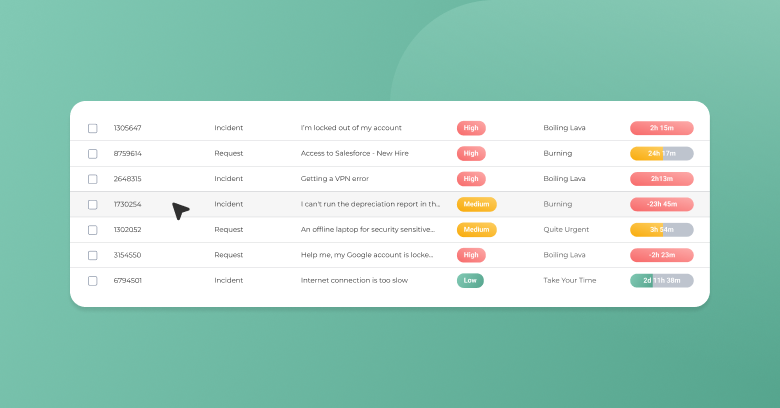Self-Service: The Benefits and 5 Tips for Success

The launching of a self-service portal – a web-based application aimed at the end users, providing 24/7 access to IT services and support – has been on the IT service management (ITSM) “hot tickets” for the last few years.
The primary driver for IT to launch a self-service portal is often to reduce the volume of calls coming in to the service desk (and thus to reduce IT support costs), but there are also benefits for the end users. For instance, many end users are now tech-savvy and want more autonomy in dealing with their own IT issues. Thus, by providing a digital interface that’s simple to use, end users would be able to handle minor issues and information requests that would otherwise come to the service desk.
For example, it’s estimated that 20-30% of calls to the service desk are password-related issues. If even half of these can be handled by the end users themselves, the reduction in calls to the service desk will be a not-insignificant 10-15%. And, with fewer inbound calls coming from less complicated issues, the service desk can focus greater resources on solving the more complex issues hurting business operations.
Self-Service Portals Defined
A self-service portal is a collection of self-help and self-service functions that are exposed to the end users. These can include any or all of the following capabilities:
- Self-logging of incidents
- Self-resolution of issues using a knowledge base
- Access to information (request status, IT service status, FAQs, and ‘how-to’s)
- Self-logging of service requests
- End-user password reset
- Chat
- Collaborative spaces
Ultimately a self-service portal should empower end users to request services, find information, and log and resolve their own issues. Essentially, the end user becomes the first line of support. This can have a positive impact on productivity and IT customer satisfaction if planned and implemented correctly, whereby the self-service portal delivers tangible benefits to the service desk, end users, and ultimately to the business as a whole.
Benefits to the Service Desk and IT Operations
For the service desk, the big benefit is the reduction in call volumes. An effective self-service portal will divert incidents, service requests, and queries away from the service desk. Instead they’re resolved by the end user or automatically routed to the right people in 2nd or 3rd line support, based on the information the end user submits.
Many incidents require multiple touch-points with the IT customer during the time it takes to fix the issue – usually when the customer wants an update on progress. An online tracking capability, for incidents and service requests, should prevent repeated calls to the service desk to check status.
Benefits to the End Users
An easy-to-use self-service portal will make self-logging, self-resolution, and other self-service activities more efficient for the end user. There’s no waiting for the service desk to pick up the phone. There’s less frustration and more time to get on with their jobs. And, if they need to, end users can easily track progress.
A self-service portal is always there, 24/7. Of course, end users only get these benefits if they use the portal. So the self-service portal needs to be easy to access and easy to use. If the user experience is clunky, they will revert to the old way – calling the service desk. Thus, a self-service portal needs to be the line of least resistance to be successful.
End-user productivity and satisfaction will hopefully improve, delivering a knock-on effect to company profitability of the company.
5 Tips for Success
1. A self-service portal is not a technology project.
It’s about making support easier for people. “Build it and they will come” doesn’t work here. The whole project needs to be framed by good communication with business colleagues – the end users. If you don’t answer their “what’s in it for me?” question then you will struggle to sell the idea of using a self-service portal to them – and it will most likely never take off. To increase your chances of success, you need to create demand for a self-service portal before you build anything. If you launch a portal that nobody wants, you’ll potentially make things worse for IT – as money will (again) have been spent on “shelfware”, and time has been spent implementing it. The audience needs to be ready and willing – and they have to see the value of a self-service portal upfront.
2. Involve end-user stakeholders in the design of the portal.
This might take time, but it’s much better to do it right slowly than do it wrong quickly. You only really have one shot at launching a self-service portal. If it doesn’t work for end users the first time, they won’t come back in a hurry. First impressions are long-lasting and previous IT project failures cast a long shadow over future initiatives.
3. The self-service portal must be correctly configured.
It needs to route requests and incidents to the right support groups first time; and to do this it must capture the right information from end users. Thus, planning and design needs to ensure that all of the information required to route and execute/resolve the case is gathered from the end user in a single step. In the absence of a complete set of information, process automation fails and IT needs to manually contact the end user to clarify the details and set the case back on the right track.
4. Run user acceptance testing (UAT) with a small group of IT-friendly end users.
Find out if it’s fit-for-purpose, and working as it should, in their eyes before you launch your portal to the wider audience of end users. If there are issues with the prototype portal, it’s better to find and fix them before you take it into the live environment.
5. A self-service portal is not a “fire-and-forget” project.
No matter how well the portal has been designed and built, there’s always room for improvement. Performance of the portal should be closely monitored on a regular basis to evaluate levels of traffic and how end users are interacting with it. The true litmus test for success is end-user opinion. Survey end users on the usability and usefulness of the portal. Ultimately, end-user adoption is critical to the success of a self-service portal. If the user experience is poor, they won’t come back to the portal and service desk call volumes will rise again. Keep an eye on performance and commit to continual improvement in order to gain increasing long-term value from your self-service portal.
That’s my five. What other advice would you give your peers on successfully introducing a self-service portal?
Did you find this interesting?Share it with others:
Did you find this interesting? Share it with others:








